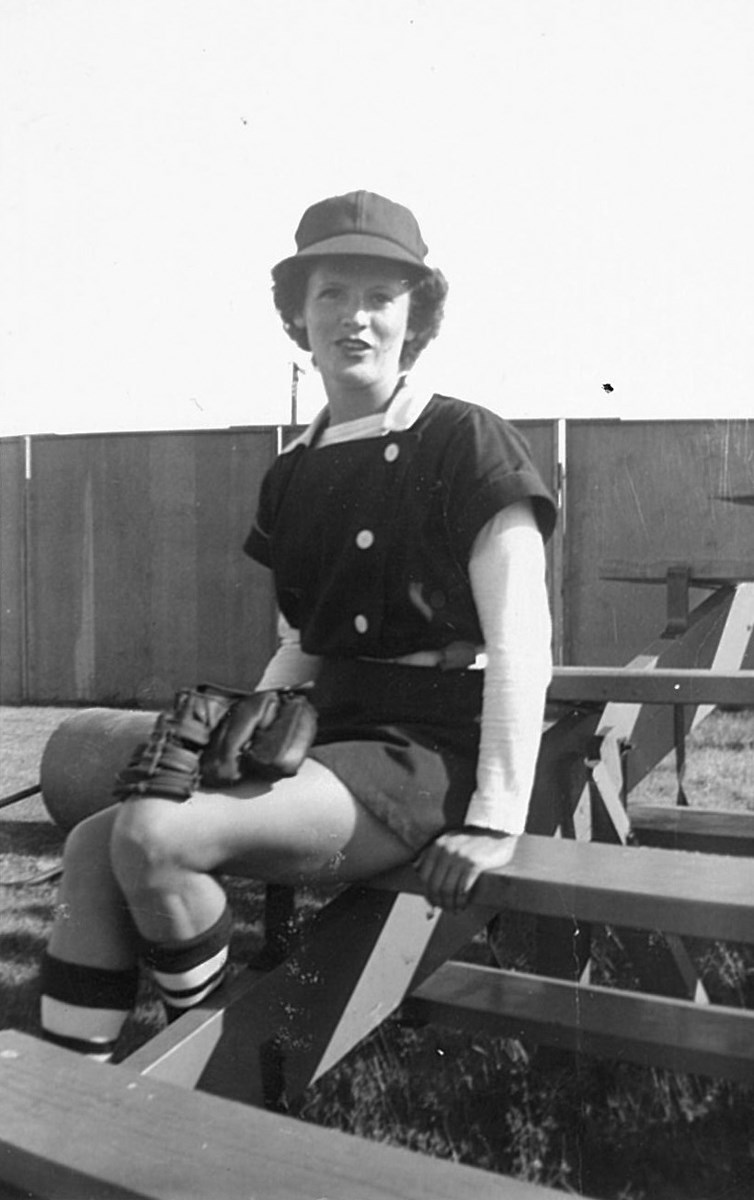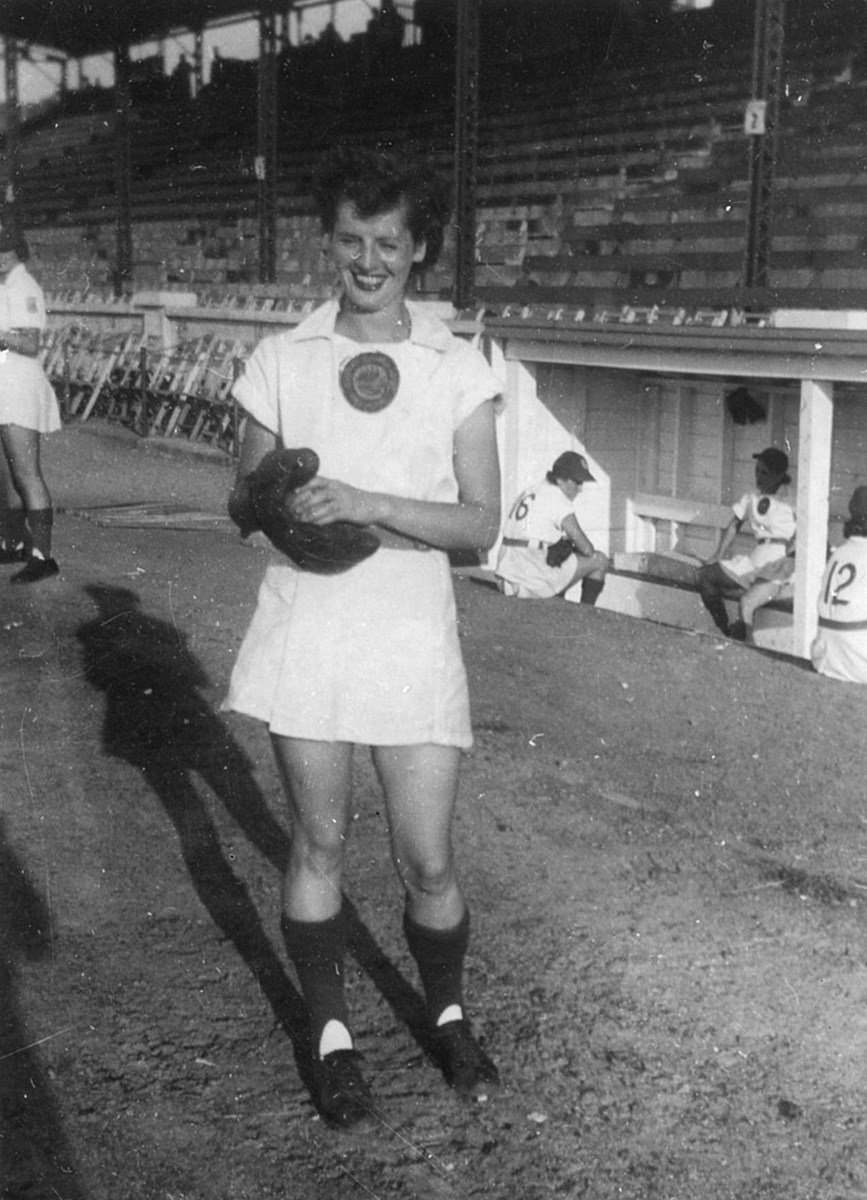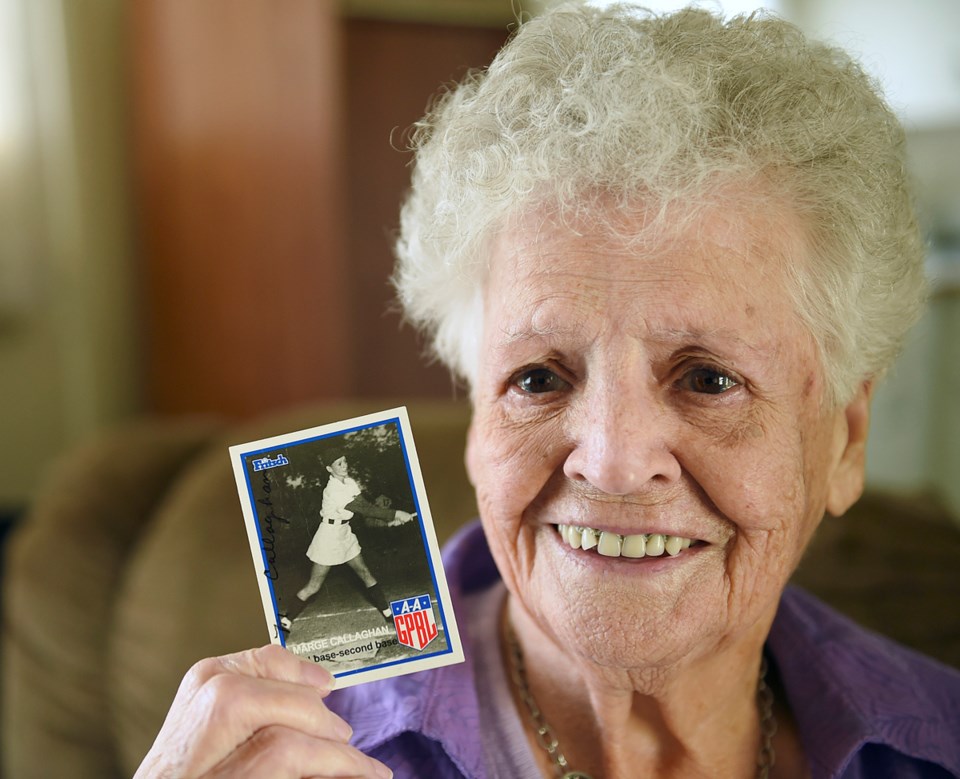As one of the savviest players in the All American Girls Professional Baseball League, Margaret Maxwell could make a great play when least expected and most needed.
Now 93 and living in Delta, Maxwell remembers a 1948 game when her Fort Wayne Daisies played the South Bend Blue Socks against a pitcher looking at a no-hitter until the Canadian laid down the only two hits of the game, both of them bunts.
‚ÄúNobody was getting any hits,‚ÄĚ said Maxwell.
The South Bend pitcher that day was likely , a right-hander from Pennsylvania who struck out 55 batters in 23 games that summer season. She also hit eight batters that year and had a 2.25 ERA.
‚ÄúI bunted on my third strike, which is a no-no,‚ÄĚ said Maxwell, ‚Äúbut I beat it out. And the next time I got up, I did it again.‚ÄĚ And again she beat the throw to first base.
‚ÄúYou‚Äôd think the third baseman would be smart enough to move in, but those were the only two hits of the game. I bet that pitcher could have killed me,‚ÄĚ she said, characteristically wry.¬†


An athlete at King Edward high school in what’s now Fairview, Maxwell was recruited to play professionally when she blasted an 11th-inning home run to win a game in the 1943 Women’s World Series of Softball held in Detroit. Her kid sister Helen was also plucked from that battlefield.
The women’s league was launched in 1943 by Chicago Cubs owner and chewing gum king, P.K. Wrigley who was worried the men’s leagues would lose money and sports stars to the war. But when U.S. President Franklin Roosevelt decided the country needed baseball for national morale, the women’s game was suddenly competition for the men’s major leagues. It endured well after the war, lasting for 11 seasons until 1954.
The 1992 movie, A League of their Own, tells the sensationalized tale of the players‚Äô real experience. Maxwell called it ‚Äúfar-fetched‚ÄĚ but also ‚Äúhilarious.‚ÄĚ Without some of that creative license, she said, ‚Äúit wouldn‚Äôt have been as good.‚ÄĚ
Her younger sister Helen, 21 at the time, jumped at the invitation to join the Minneapolis Millerettes in 1944. Maxwell, then 23, had a war-time job as crew chief at the Boeing plant in Richmond and stayed behind for half the baseball season.
‚ÄúI never gave it much thought because I didn‚Äôt really think I wanted to go in the first place,‚ÄĚ she said. ‚ÄúI only went because [Helen] went, and my father wanted me to go down to keep an eye on my sister.‚ÄĚ
Helen (Callaghan) St. Aubin, nicknamed Cally, died in 1992.
Price of admission
In their first year playing professional softball ‚ÄĒ the baseball would come later ‚ÄĒ ¬ť∂Ļīę√Ĺ”≥Ľ≠sisters Margaret and Helen Callaghan earned $65 a week playing for the Fort Wayne Daisies in Indiana. It was 1944.
Margaret, surname now Maxwell, left a senior position in a war-time manufacturing plant and soon earned $85 a week as an athlete. ‚ÄúI made more money playing ball than I did at Boeing,‚ÄĚ she said.
Helen, married name St. Aubin, made the top salary of $125 as a lead-off batter.  
In the league’s first season in 1943, weekly salaries ranged from $45 to $85 (or $613 to $1,158 in today’s US dollars). Spectators paid 74 cents to see one of four Midwest teams, the Kenosha Comets, Racine Belles, Rockford Peaches and the South Bend Blue Socks.
A Fort Wayne men’s baseball team charged 50 cents a ticket and drew an average 500 spectators while the Daisies averaged 1,300 fans, a low turnout compared to the 2,000 or 3,000 average in later seasons as the league expanded.
To compare the costs, a dozen eggs cost 64 cents and a hot dog sold for about a nickel in the mid-1940s.
Maxwell received government permission to leave her war job and joined her sister on the Millerettes where she was thrown into a game against the Millwaukee Chicks the day she arrived. ‚ÄúThat was a shock,‚ÄĚ quipped the bright-eyed nonagenarian.
Playing third base, Maxwell soon became a star, earning the best fielding average for the position in 1944 and 1945 and the best put-out average in 1946.
Helen, the Daisies’ lead-off hitter, shared the league’s batting crown in 1945 with a .299 average. That season she had three home runs, four triples and 17 doubles.
In 1947, Maxwell hit a home run that left  and was thought to be the longest homer ever hit in the league.
There were other perks to good performance, said Maxwell. ‚ÄúWe often got things from the fans. They would buy you jewelry if you hit a triple, and one year the fans bought all the girls a wristwatch.‚ÄĚ
Attendance first lagged, but grew to rival the men’s leagues as it offered a new and exciting spectacle. During spring training before the 1947 season, the women went to Cuba where one game brought in 20,000 fans and outdrew the Brooklyn Dodgers.
Sibling hit and run
Strict codes of conduct ‚ÄĒ and superficial rules such as constantly wearing lipstick and never having short hair ‚ÄĒ reflected women‚Äôs restricted roles as feminine entertainers. Maxwell said she and Helen never attended the league‚Äôs charm school, which ran prior to the inaugural season.
With flashy pink, yellow or burgundy uniforms and short skirts flying, the teenage and 20-something women played their hearts out. Audiences were enthralled. The game also had experimental rules. The ball started out softball sized, but shrank in increments over 11 years to the same size as a regulation baseball. (The league was first called the All-American Girls Softball League and had several name changes while in existence.) Pitchers threw underhand from a flat mound, but over time, the mound moved farther away from the batter’s box and pitchers threw overhand. Base lines were longer than regulation softball but never as long as in men’s baseball, and players could lead off and steal.
Maxwell broke her ankle one year sliding, and many players had bruises and ‚Äústrawberries,‚ÄĚ basically wounds and scrapes. They could wear sliding pads or long socks, but that wasn‚Äôt always enough, she remembered. ‚ÄúSome of the girls had half their skin [gone], like Faye Dancer. She was always wrapped up in bandages.‚ÄĚ
Maxwell avoided most of those scrapes by popping up after a short slide. Shrewd, strong and versatile, her record-setting homer in 1947 drew this description from a sportswriter: ‚ÄúMarge Callaghan, 110 pounds soaking wet, hit the longest home run in this park so far‚Ķ Betsy Jochum is still chasing it.‚Ä̬†
Although a solid hitter with a .196 batting average over eight seasons, Maxwell loved to bunt. With the Millerettes, she batted after her left-handed sister and often advanced Helen to second or third base. Although the league didn’t count a sacrifice bunt as an at-bat, she never minded.
‚ÄúBut that helps your time at bat anyway,‚ÄĚ she said. ‚ÄúI never worried about it.‚ÄĚ
When Maxwell left the game and the limelight, she was as cool as when she first stepped into it. ‚ÄúI got married. My last season was 1951. I just shifted into married life.‚ÄĚ
The league ended in 1954. Maxwell is enshrined at three different halls of fame in Cooperstown, Ontario and British Columbia.



